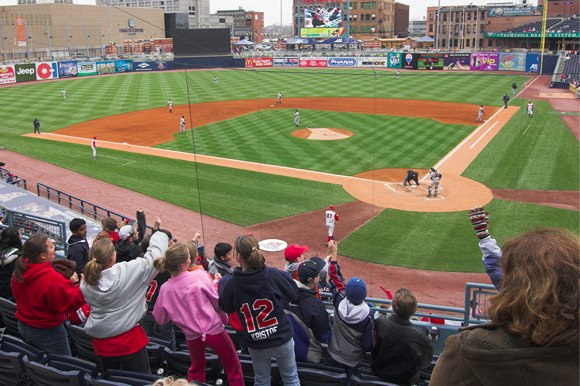
Are we seeing more evidence that ballpark construction is indeed an economic catalyst? Two recent case studies in Toledo and Washington provide some compelling arguments for the proposition.
Today The Atlantic looks at Fifth Third Field, the home of the Toledo Mud Hens (Class AAA; International League), and how it’s providing some $50 million in economic impact for downtown Toledo:
Since it opened in 2002, the park, named after the Cincinnati banking chain, has sparked an estimated $50 million in economic development, even though the outskirts of its neighborhood are still dotted with empty lots and abandoned buildings. The community revival was by design, says Joe Napoli, the Mud Hens’ general manager, who was part of the team that developed the ballpark.
“We looked at suburban parks and urban parks and decided to take a page out of the urban book, which says, if you build a ballpark in an urban setting, you have a tremendous opportunity for development,” he says.
Of course, there are those who will deny any meaningful impact from a ballpark even in a situation where there’s clear evidence of economic development in an area. Take, for example, Nationals Park, home of the Washington Nationals. When it was pitched by local politicians, the argument was that it would help revive a moribund area of the Washington, an area filled with empty lots and little industry.
The ballpark opened in the midst of a recession, so the economic impact wasn’t immediately felt, but local business leaders now say the presence of Nationals Park as being a reason for large-scale investment in a run-down part of the District of Columbia. That’s not stopping anti-ballpark folks from saying that the ballpark has little to do with development in the area; hey, it would have happened anyway! From Washington City Paper:
Of course, the stadium had something to do with the growth of the neighborhood, and certainly seems to be paying back its construction cost in the form of sales taxes. Little else would regularly bring tens of thousands of people in from Virginia to spend money in the District on a regular basis, as Fisher noted. But is it responsible for all those buildings sprouting up around it?…
The baseball stadium is clearly an economic benefit to the city, especially when the Nats are winning. But crediting the stadium with the creation of a new neighborhood is just too convenient: With D.C. on the rise, for a transit-served area between Capitol Hill and the waterfront, it was only a matter of time.
But was it? Unless CP has invented a magical time machine that allows you to go back in time and change the future, we’ll never know whether this development was inevitable. In this case, Occam’s razor is a good guide here: since the ballpark was built and the development is happening in a previously moribund area, the simplest explanation is that the ballpark helped drive that development, especially over a time span where the economy has clearly been slowed down and new investment hard to find.
RELATED STORIES: Nationals Park: Catalyst for development
—-
Share your news with the baseball community. Send it to us at editors@augustpublications.com.
Are you a subscriber to the weekly Ballpark Digest newsletter? You can sign up for a free subscription at the Newsletter Signup Page.
Join Ballpark Digest on Facebook and on Twitter!
Follow Ballpark Digest on Google + and add us to your circles!
